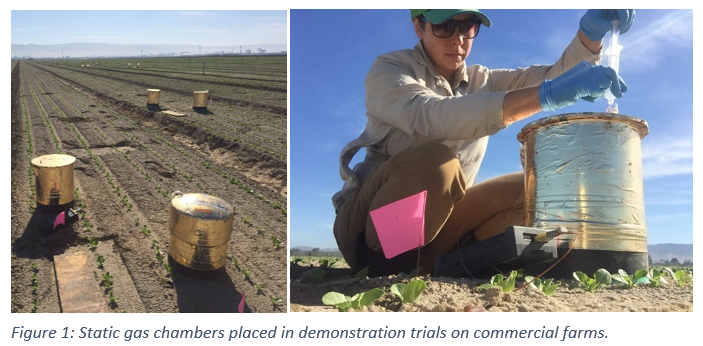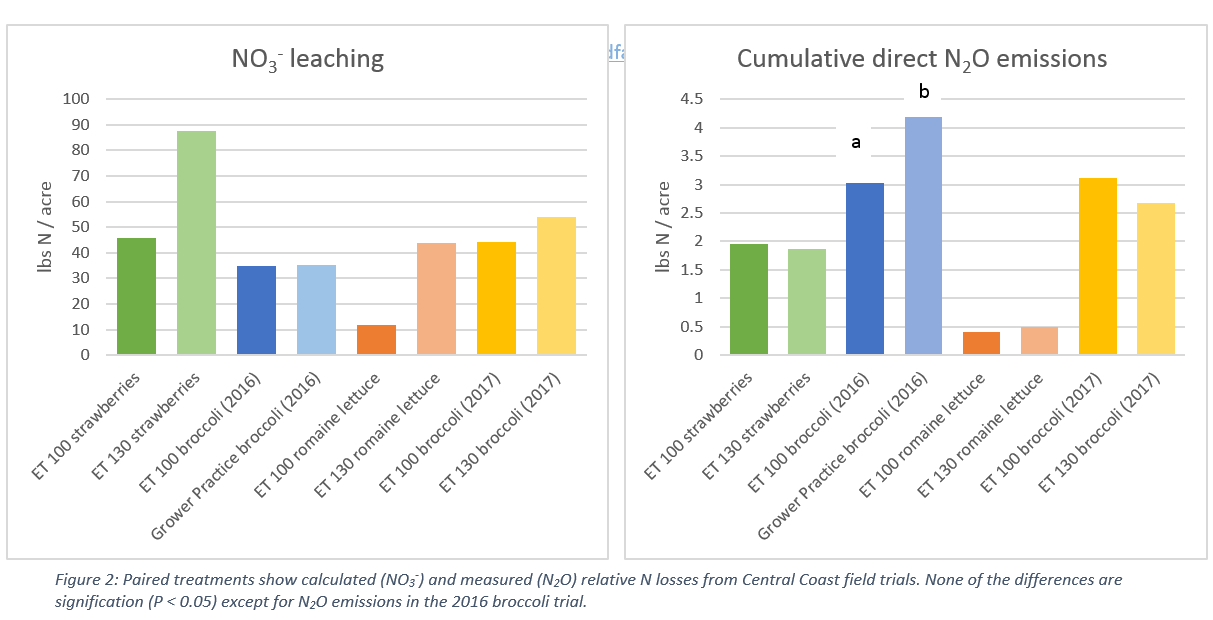Project Title: N2O emissions under different on-farm irrigation and nutrient management BMPs that reduce groundwater nitrate loading and applied water
Project Leader: Arlene Haffa, School of Natural Sciences, California State University, Monterey Bay
Location: Central Coast
Focus Crops: Strawberry, Lettuce, Broccoli
Overview: The primary goal of this project is to develop a better understanding of farm management practices that can be implemented to reduce nitrous oxide (N2O) emissions from agricultural soils without leading to yield loss.
Issue: N2O is a greenhouse gas that is 300 times more potent than carbon dioxide (CO2) at warming the atmosphere.
In agricultural systems, N2O can be a byproduct of nitrification and denitrification, the natural transformations of nitrogen between mineral nitrogen compounds, mediated by soil microbes. Both pathways can occur simultaneously in the soil, but the dominant process is determined by the oxygen content, which is controlled by soil moisture. As shown in the figure below, these processes and N2O production are driven by fertilizer and organic matter inputs, irrigation, and tillage practices.

To decrease nutrient loss from agricultural soils and improve nitrogen and irrigation efficiency, the University of California Cooperative Extension (UCCE) developed a tool for growers called CropManage. CropManage is an online support tool that aids in irrigation and nitrogen scheduling on a per-field basis. In this study, researchers conducted field trials on commercial farms in the Salinas valley to quantify the benefits of using tools such as CropManage to support best management practices (BMPs) in strawberries, broccoli, and lettuce.
Experimental Design: Researchers set up demonstration plots on commercial farms to compare CropManage recommendations (100% ETc and N) to the grower standard and excess irrigation and fertilization (130% ETc and N). The CropManage recommendation represents the BMP for each crop.
Direct N2O emissions were measured using static gas chambers placed between plants in each of the treatment plots for strawberries, lettuce, and broccoli. The PVC gas chambers, pictured below, were inserted to a depth of 5-8 cm for 2-24 hours before sampling. Sampling occurred 1-2 times per week depending on activities in the field. Activities that enhance N2O production such as fertilization, irrigation, and precipitation events required more intensive monitoring.
Additional instrumentation was used to measure environmental and soil conditions known to impact N2O production, including soil moisture, soil temperature and electrical conductivity (EC).

Preliminary Results: Aside from direct emissions measurements, by using the static gas chambers, researchers also measured nitrate leaching and crop yield. Nitrate (NO3–) leaching data was used to estimate indirect N2O emissions. The graphs below display results for cumulative direct N2O emissions, and preliminary results for NO3– leaching for each crop and treatment.

Discussion: Across each experiment and crop type, the CropManage treatment, ETc 100, showed comparable yields while reducing nitrate leaching and indirect N2O emissions. Preliminary results also showed a significant difference in cumulative N2O emissions between the ETc 100 and grower treatments in the 2016 Broccoli trial.
Other comparisons showed no statistical differences in cumulative N2O emissions. For transformations, such as nitrification and denitrification to occur, N must be present in the upper soil profile where microbes are most abundant. In the treatments with excess irrigation levels, more nitrate was leached from the upper soil profile. With less nitrogen available to soil microbes, N transformations may have been reduced, causing the observed differences in cumulative N2O emissions to be minimal. Additionally, the fields maintained a water filled pore space of less than 70% for most of the study, which may have limited denitrification and the associated N2O production.
Take Away: This study shows that indirect and direct emissions from soil microbial processes can be better managed through improved irrigation and nutrient management practices. Moreover, the research provides insights to the benefits of using web-based management tools such as CropManage. Following CropManage recommendations produced comparable yields in these crops and led to reductions in nitrate leaching.
For more information on CropManage visit: v3.cropmanage.ucanr.edu
This post is an update to a current FREP funded study. For more information, the full project proposal can be found at: https://www.cdfa.ca.gov/is/docs/15-0356-Haffa.pdf


